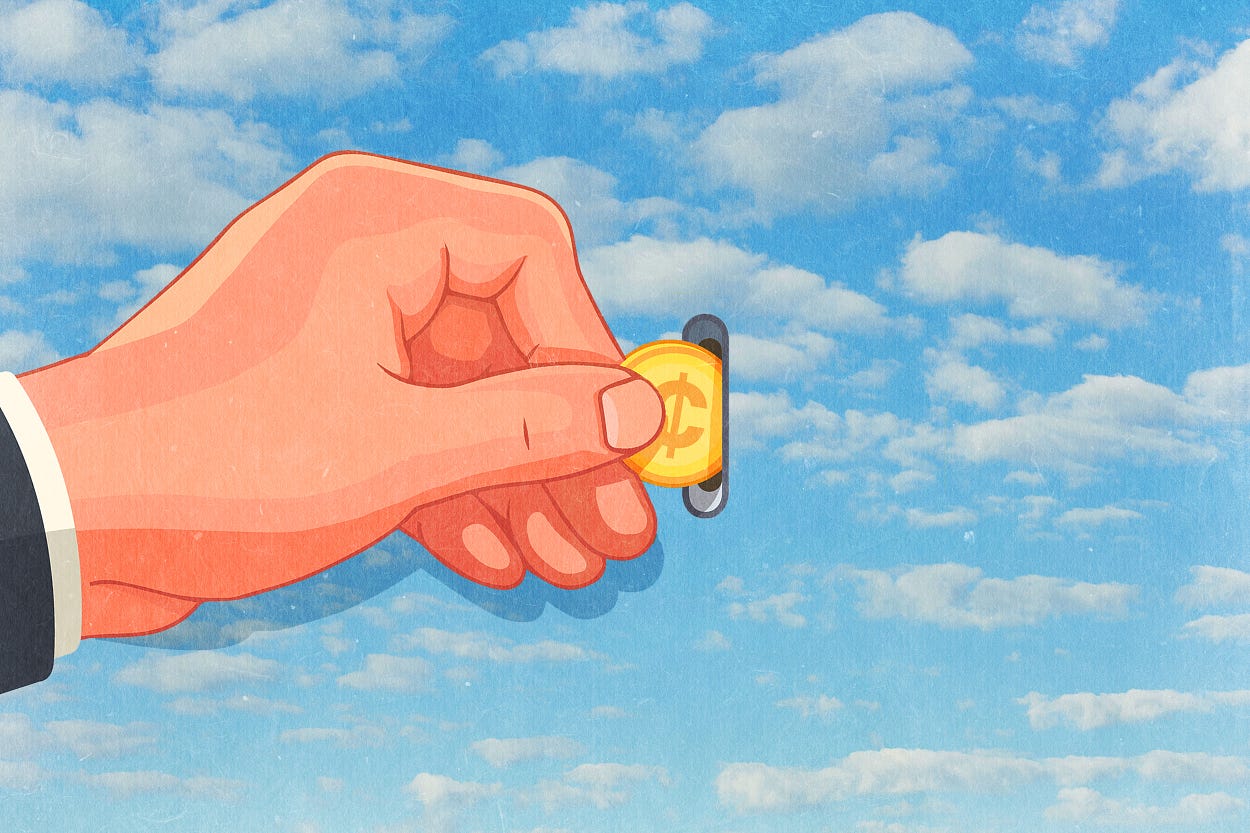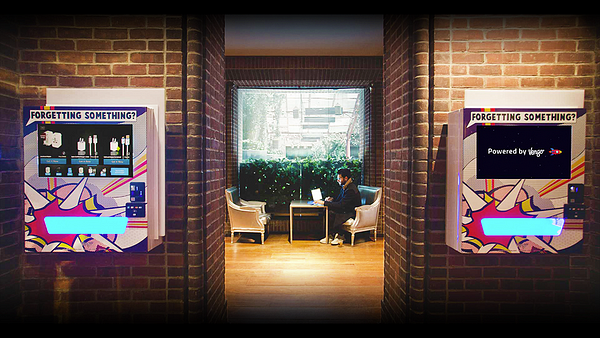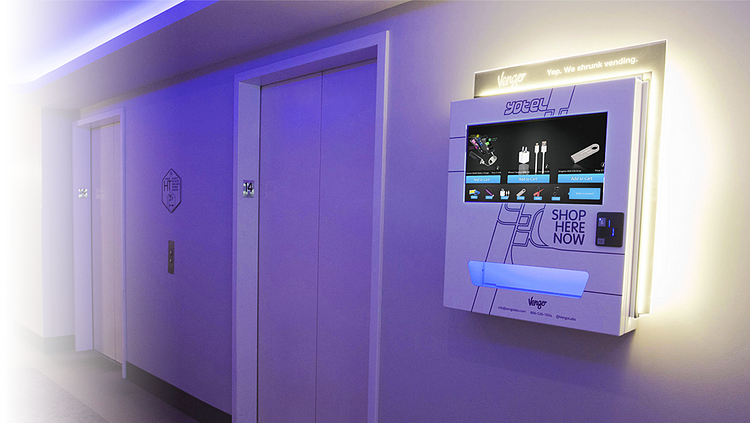They aren’t the most exciting piece of technology out there, but the advanced contraptions popping up in airports and elsewhere could redefine how we consume, well, everything.

(Getty Images/Ringer illustration)
In November, a new genre of YouTube video emerged. The premise was simple: Vloggers documented their long and often trying journeys to pay tribute to a big metal box as it traveled across the United States, from Venice Beach to Catoosa to the Grand Canyon to Manhattan.
No matter where it is shot, each video leads to the same scene: The protagonist comes face to face with a bright-yellow, rectangular “bot” and its single blinking video-screen eyeball. He or she pushes one of three colorful, bulbous buttons, which transforms the eye into a screen superimposing Snapchat’s latest product — video recording glasses called Spectacles — onto his or her face. The quest concludes with a financial transaction: a dip of the credit card, an R2-D2-esque beep-boop-bop, and the bot’s flashing mouth spitting out a pair of the precious shades. As a nod to one of Snapchat’s original face filters, it also prints a rainbow-colored receipt for the $130 purchase.
Though this whimsical bot was designed to build hype for Snap’s first hardware product, its presence was reason enough to endure the long drives, lines, and — in the case of the Grand Canyon location — helicopter flights. “The Snapbot is real. I touched it,” YouTube star Julien Solomita said, in awe, to his camera after buying two pairs of Spectacles on the Santa Monica Pier. “I’ve never seen anything like that.”
But the concept was all too familiar to vlogger Krispyshorts, who waited five hours in the cold at the bot’s NYC location. “You just gotta go up, put your credit card in, and it comes out in the kiosk,” he said in his video. “Like a vending machine.”
Snap’s Spectacles rollout may have been the most successful gadget announcement of 2016, but the marketing campaign also managed to drag another, slightly more mature tech product into the spotlight, one that’s older than the company’s 26-year-old CEO, Evan Spiegel.
Among the crowd of vloggers, Snapchat superfans, and tech journalists who flocked to Snap’s Fifth Avenue storefront in November was 29-year-old native New Yorker Adam Gartenberg. He wasn’t there to Periscope his experience or even purchase Spectacles, but to inspect the magical vessel that delivered them.
“I was that guy that was going on the side of the machine, going on the bottom, trying to go on top,” Gartenberg said. “I wanted to see everything: what they did to build it, the software, how they paid for it — all that stuff.”
Such details are important to Gartenberg because he is the vice president of business development at Vengo, a vending machine startup that designs and distributes metal wall fixtures with touch screens that dispense everything from PowerBars to eyeliner in hotels, gyms, and colleges around the U.S. His company is one of the most prominent members of the vending industry’s new guard, a small but innovative group of businesses that have tapped into new technological and marketing potential for the decades-old concept. Whether it’s a matter of gathering information on customers, giving people a reason to tweet about a product, or simply establishing a brand’s presence in a bustling location, these companies have begun to reimagine the vending machine as a malleable and commanding vehicle for advertising.
The Vengo is by no means as interactive (or high budget) as the Snapbot, but it’s a far cry from the dusty, hulking soda and candy dispensers of yore. Even using the words “vending machine” to describe the product irks Gartenberg.
“I hate the phrase because if I say that phrase to you, you’re thinking of an old box, and it’s got the coils and it’s got a quarter slot,” he said. “I want to go so far away from that.” He and others I spoke to prefer “retail experience” as a replacement term.

Vengo machines outside the lobby bathrooms at the Hudson Hotel in Manhattan (Vengo)
I’m not sure what an old-school vending machine oligarch is supposed to look like, but I can’t imagine it’s like Gartenberg. We met outside the bathrooms in the Hudson Hotel lobby, where one of his company’s touchscreen-equipped boxes, decorated in the style of a Roy Lichtenstein painting, is attached to a brick wall. Gartenberg looked like someone at a Kanye West concert: white sneakers, loose gray pants that approach the category of “fashion sweats,” a hoodie beneath his navy Stussy bomber jacket — all finished off with some leather man-bracelets. His square, wire-rimmed glasses framed a handsome face with a beard that was a few days past a five o’clock shadow. While explaining things, he had a tendency to play with his hair, which was hidden beneath a black, labelless hat the day I met him. When we sat down in a pair of silver chairs to talk, he placed his iPhone 7 and earbuds on the table face up to reveal an unrelenting flow of Snapchat and Slack notifications.
You may have seen Vengo on Shark Tank last year, when company cofounders Brian Shimmerlik and Steven Bofill secured a whopping $2 million investment. But if you haven’t, here’s a rundown of the company’s business model: Its slim, patented boxes hang in public spaces like picture frames, holding up to 100 items each. Vengo doesn’t stock these vessels, so it sells them to major vending operators like Canteen, which have the resources and staff to do that. The company instead makes money by controlling the advertisements on each box’s touchscreens along with a portion of the products that they sell. A brand like Kiehl’s will pay to have its product featured for the sake of exposure and the ability to collect data on how its products are selling. When customers approach, they might be prompted to take a selfie with the company’s logo and post it on Facebook in exchange for a lotion sample. Or a person might be asked to take a survey. Either way, the encounter is an invaluable way for brands to momentarily wrestle a consumer away from his or her busy day for some light brand promotion.
“It’s so freaking hard now to get attention,” Gartenberg said. “Everyone’s face is in their phone. But when you say: ‘Hey, listen, if you take this survey, the product will fall out in the next eight seconds,’ it becomes incentivization. As opposed to being on a browser, where it’s: ‘Hey, take this survey and we’ll ship something over to your house.’ There’s an immediacy game here.”
Vengo may be selling a digital iteration of a classic product, but it is just one of many companies to recognize that people enjoy buying things from robots. The first vending machine’s draw, however, wasn’t instant gratification but regulation. And it was not designed to hold condoms, chapstick, or 100 Grand bars, but holy water. In the first century BC, a Greek mathematician and engineer, Heron of Alexandria, was confronted with a problem in his Egyptian city: Denizens of the local temple were taking more holy water than they’d paid for, like college students drunk with power in a Whole Foods prepared-food section. So he invented an apparatus that required tokens to access the liquid. Drop a coin in, and its weight would push against a lever that opened the spout, where holy water would run out. The coin would eventually fall so that the spout would be cut off. According to Vending Machines: An American Social History, there’s no evidence that the dispenser ever made it past a sketch in Heron of Alexandria’s stack of parchment. But it is indisputably the first record of an “automated retail solution,” as the brands call it these days.

The wall fixtures are customizable, selling everything from chargers to deodorant (Vengo)
It took a surprisingly long time to improve upon Heron’s holy water apparatus. A pencil vendor popped up in China around 1076 AD, as did a collection of coin-operated tobacco dispensers in English taverns in the 1600s. But it wasn’t until 1883, when an Englishman named Percival Everitt was awarded a patent for a machine that sold postcards and stamped envelopes, that the vending machine began to capture consumers’ imagination. “We should not be surprised to see this ingenious vendor before long supplying small objects of regular prices and dimensions such as boxes of matches, cigars, omnibus tickets, etc.!” read one account from the time. Even back then, the contraptions were an excellent way to get some good PR.
The first major moment for vending in America came in 1888, when the Adams Gum Company plopped a few penny machines filled with Tutti-Frutti onto the platforms of New York City’s elevated rail stations to relative success. After that, the possibilities of where to put these boxes and what to stuff in them only expanded — from peanuts and cigarettes in America to expensive perfumes and wine in France. Before modern manufacturing was able to produce single-purpose vending machines at a steady clip, their contents ebbed and flowed with the needs of whatever community was responsible for stocking them.
“A great man once described the vending machine as a ‘labor storage device,’ which allows me to stock a machine with things at my convenience, and you to buy something from it at yours,” Timothy R. Sanford, the editor of the trade publication Vending Times, wrote to me via email. “This is the whole raison d’être of full-line vending equipment.”
As people demanded more from these sovereign lockers, they underwent a steady course of innovation in the 20th century. The original Coca-Cola dispensers of the 1930s were just ice boxes mounted on countertops or walls that often relied on a store-clerk-supervised honor system. It wasn’t until 1950, when manufacturers figured out how to refrigerate the insides of these hulking containers, that a wave of them began serving good ol’ American sandwiches, soft drinks, and milkshakes. Arguably the most helpful breakthrough came in 1965, when John Greenwick invented a bill acceptor that attached to any machine, paving the way for more significant purchases like, you know, $130 camera-equipped sunglasses. By 1972, snack machines with fully transparent glass screens hit office hallways, and in the following decades frozen snacks, DVDs, and office dongles followed.
Today, the world knows no limits for what vending machines can contain. Some examples include: live crabs, randomly selected books, gold, Calvin Klein underwear, prescription drugs, flip-flops, dinnerware, live insects, bike parts, human DNA, and salads. But the products that populate the more than 6.9 million vending machines in the U.S. are usually much simpler than that. Most of the machines are placed in common-sense locations like company break rooms, courthouse hallways, hospital waiting rooms, convention centers, and transportation hubs. And more than half of the money earned by those machines comes from cold, refreshing beverages. Many of us know what it feels like to flatten a wrinkled dollar bill on the edge of a vending machine with the hopes of soon sipping a fizzy soda.
The kind of machines that tend to get brands noticed, on the other hand, are custom-made creations that are interesting to blog about. Famous examples include Sprinkles’ cupcake ATM, a street-facing kiosk that uses robotic arms with suction cups that grab pastries in individual boxes and gently push them into an open slot for customers to grab. (Since launching its first kiosk in 2012, the company has added 13 more, but remains tight-lipped about the European firm it hired to design the machine.) Near ubiquitous in high-trafficked U.S. airports are Benefit’s powder-pink bus-shaped kiosks, whose interiors come equipped with inventory-detecting lasers and cameras. According to VP of global strategic marketing Susan Kim, the machines inspired some international travelers to write the company letters about their Benefit kiosk treasure hunts. And of course there’s the occasional Coca-Cola stunt — which has required customers to do everything from hug to dance in order to receive a beverage from a vending machine. Not all of these machines earn a cold, hard profit, but they guarantee plenty of customer-generated publicity.
Still, brands didn’t always see their value. When Patrick McDonald and Jeff Thibodeau founded their company, Innovative Vending Solutions, more than nine years ago, they had to pester clients to try machines that allowed customers to tweet, Facebook, or Instagram from their touchscreens. But within the past five years, the two say that demand for the features has finally picked up. Now with more than 400 customers — made up of retailers, marketing groups, and ad agencies — the custom vending machine manufacturer is looking into new technologies like facial recognition and robotic-arm delivery systems to anticipate what their clients might want next.
“People find a need to tell everybody else what they do and when they’re doing it,” McDonald said. “To incorporate this into a machine and to tell somebody: ‘Hey, guess what I just bought in this cool machine.’ It goes viral in just a matter of seconds. That’s your 21st-century word of mouth.”
According to Adam Gartenberg, it’s exactly that concept that longtime vending suppliers and manufacturers — which he calls an insular, old-school community he likens to a mafia — are remiss to recognize. But rather than take the typical route of a Silicon Valley startup and attempt to bypass his predecessors, Gartenberg has learned to work alongside them. His company of 14 people is far too small to service the more than 550 machines that Vengo has, and he has learned it’s easier to rely on 35-year-old servicing companies than it is to start from scratch.
“You think that because it’s a new tech company, I’m going to do everything on my own, I’m going to do it in a better way, so we don’t really need the older guys,” he said. “But in a sense that’s the marriage. The old way to do it is the right way and it’s the fast way to do it. On our end, it’s another way to monetize now with software. So it’s the best of both worlds.”
Gartenberg continues to think about Snapchat’s flashy vending machine launch. After several months of obsessively following the Spectacles bot treasure map for its latest location, he even sent Evan Spiegel an email introducing himself. (Spiegel has yet to reply.)
“I started to totally fantasize,” he said. “Like, is this an opportunity for a company who wants to find a way to get a product out there in a unique manner? Instead of it being on a website, it’d be amazing if an Oculus or a Samsung said, ‘Hey, why don’t we use Vengo for this for eight months?’”
Just think: A VR headset vending machine may be in our near future. Unnecessary? Sure. But definitely worth tweeting about.
